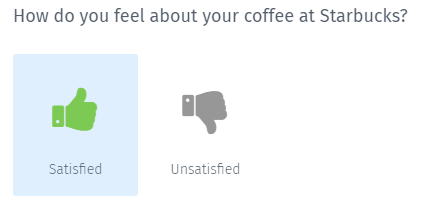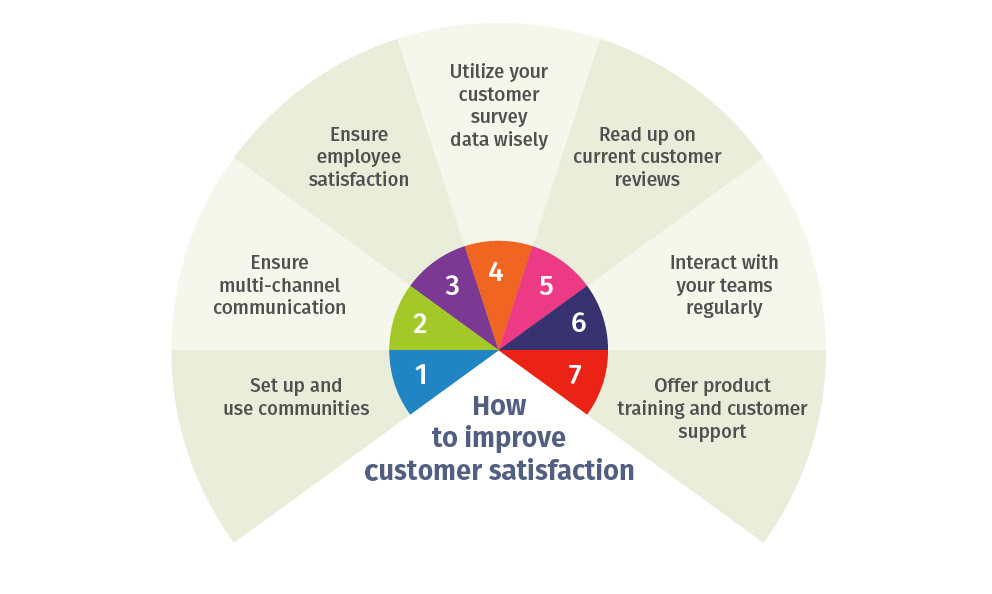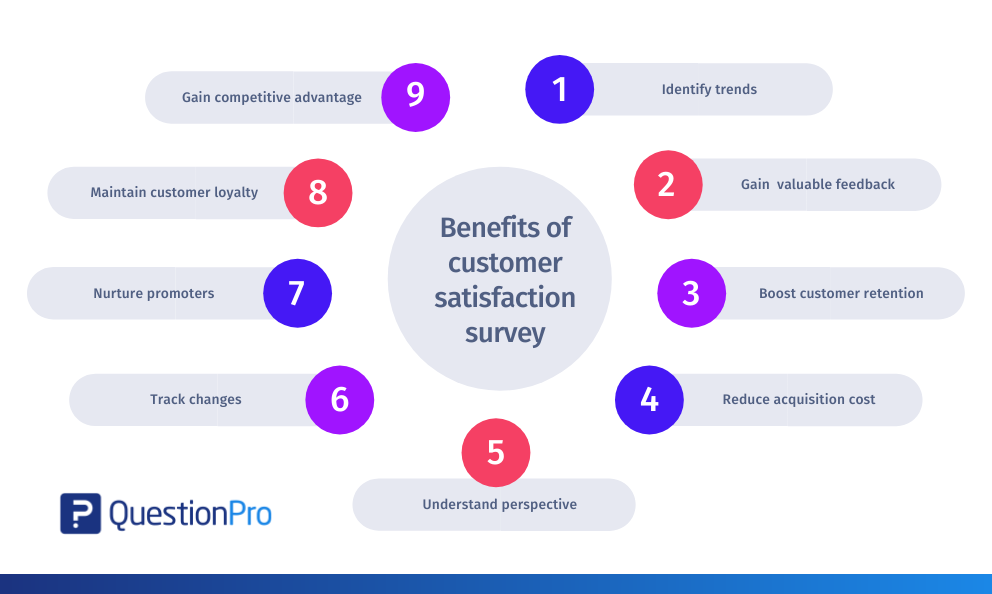What is customer satisfaction?
Definition: Customer Satisfaction (CSAT) is defined as the measure of a customer's happiness with a company’s product, service, or capability. It is a commonly used term in marketing and a barometer of how well a company’s offerings meet customer expectations.
One of the most popular options to measure satisfaction is through a CSAT survey. A survey, often created from questionnaire templates, is distributed to the relevant audience. Your customers answer the questions, giving you insights into their feelings of satisfaction or a lack of it with your offerings.
Organizations use data from multiple sources to improve Customer Experience (CX) and grow sales. Metrics such as Customer Satisfaction Score (CSAT)
, Net Promoter Score (NPS), or Customer Effort Score (CES) are used to provide decision-makers with an easy-to-understand score based on the survey results.
How to measure customer satisfaction?
Determining how satisfied your customers are is achieved by asking a single question within customer surveys
as follows:
Considering all your experiences with our company, products, and services, how satisfied are you?

Learn more: Methods of measuring customer satisfaction
Customer satisfaction questions
Asking the right questions is important to ensure you get the right and relevant feedback. Asking vague questions collects inaccurate data. You may lose out on important insights that could have helped you refine your customer experience initiatives. Some of the areas you should cover in your customer satisfaction questionnaire are:
- Demographic questions
- Product/service usage
- Design
- User
- Experience
- Performance
- Customer support
- Competitors
Learn more: The most important CSAT questions
Possible answer variants for determination of CSAT
Typically, companies use a 5-point CSAT score scale. However, they can make it a 3-point or 7-point scale too, depending on the depth of data needed.
- Very satisfied
- Satisfied
- Neutral
- Unsatisfied
- Very unsatisfied
- Completely satisfied
- Very satisfied
- Somewhat satisfied
- Somewhat unsatisfied
- Very unsatisfied
- Completely unsatisfied
- Very satisfied
- Somewhat satisfied
- Somewhat unsatisfied
- Very unsatisfied
For mobile surveys, the questionnaire and answer options should be designed briefly and clearly to achieve the highest response rate.
Numerical values for customer satisfaction measurement
Another way to measure CSAT is to use a 10-digit scale, similar to that of the Net Promoter Score (NPS) questions, with 1 being the worst and 10 being the best.
 Graphical answer options to measure customer satisfaction
Graphical answer options to measure customer satisfaction
1. Smileys
Smileys are very popular to measure the satisfaction level. They present an exciting and refreshing way to show the options of a CSAT question. You can also customize the smiley faces to add your own scale.

2. Thumbs up/down
It is another simple way to gather feedback and know if they like your products and services.

Examples of customer satisfaction surveys
The type of customer satisfaction survey depends on the focus of your study.
Are you trying to judge the quality of your service or know how the customer feels?
Or do you want more insights into why your product is doing well?
As these questions are different, so are the surveys you need to conduct. Below are some of the common customer satisfaction survey examples.
- Voice of customer surveys: This type of survey measures opinion on important business parameters. Use these questionnaires to create products that are quite likely to be accepted by the users. You can also collect feedback post the usage.
- Service evaluation surveys: Service promptness, ease of getting service, and staff responsiveness are key to satisfied customers. A service evaluation research gives you access to insights on your current level of customer service and the improvement areas.
Some of the Fortune 500 companies use some customer satisfaction survey software to listen to the voice of the customer (VoC). The data is used to measure customer satisfaction and get more insights into their expectations.
- Nike
- Subway
- Delta Airlines
- McDonalds
- FedEx
- Walmart
- Apple
Explore further: Best customer satisfaction survey examples
Customer satisfaction metrics
Poor CX is one of the primary reasons why customers stop interacting with a brand. Here are some of the commonly used CSAT survey metrics to measure your customer experience:
1. Customer Satisfaction Score (CSAT): You can calculate the CSAT score by asking customers to rate their level of satisfaction on a scale of 'Not satisfied' to 'Very satisfied'.
Learn more: 7 Methods for CSAT measurement
2. Net Promoter Score (NPS): It is the percentage of the customers that will recommend your company or business to their family or friends. You can calculate NPS score by asking a simple NPS question:
On a scale of 0-10, with 0 being the lowest and 10 being highest, how likely are you to recommend us to your family or friends?
Based on the answers, the respondents are categorized as below.
Score 9-10: Promoters, who would recommend your business to others.
Score 7-8: Passives, who are not too happy and have a neutral stand.
Score below 7: Detractors, who are not satisfied and likely to stop buying your products and services.
Learn more: NPS calculation with formula
3. Customer Effort Score (CES): It is a metric used to measure customer experience. An organization strives to create products that offer 'effortless' experience. Less efforts often translate into excellent experience and high satisfaction.
For example, if customers must continuously walk around in a retail clothing store to find staff for assistance, it will amount to poor CX. Whereas, an attentive service staff member anticipates needs and offers help proactively. In the latter case, the customers is more likely to return to the store.
Learn more: The complete guide to Customer Effort Score (CES)
4. Customer Churn: It is also known as customer attrition. It is the percentage of customers who are not likely to purchase from a business. Due to bad CX, they stop buying products or services from a brand. To calculate the churn rate, divide the number of customers you have lost by the total number.
Highly satisfied customers are great brand ambassadors. They help spread a positive word of mouth and recommend your brand or services to their family, friends, and colleagues. It is crucial to keep the churn rate low for any business, as acquiring new customers costs more than retaining existing ones.
Learn more: Customer churn rate calculation and how to reduce it
When to measure customer satisfaction?
The best time to conduct a customer satisfaction survey is immediately after the point of experience. As the emotions are still afresh in memory, researchers can trust the CSAT data. However, CSAT surveys must be conducted at regular intervals to check for any change in experience with the change in time.
While organizations can collect user feedback at various points of interaction, customer satisfaction questionnaires are primarily divided into two categories.
- Direct transaction survey: This type of customer satisfaction survey is conducted when the organization requires immediate feedback after the transactions. For example, a store asks buyers to respond to a quick survey after purchasing a product, or a pop-up survey appears after an online transaction. Questions aim to gain insights into the shopping experience that just occurred. The purpose of conducting this survey is not to understand the detailed opinion, but rather to keep a tab on the latest transaction experiences.
- Overall satisfaction survey: These surveys are conducted to understand an organization’s overall reputation in the eyes of the customers. They’re also known as “relationship surveys” as they’re used to maintain customer relationships. Usually, they are conducted in the disguise of direct transaction surveys. They help the organization learn about customer satisfaction level based on the entire experience while limiting any bias.
An ideal frequency of sending these questionnaires would be once in a quarter. It would vary depending on the frequency of purchase. A mix of direct transaction survey and overall satisfaction research would collect the right data on customer behavior.
How to improve customer satisfaction?
You can improve satisfaction by enhancing all touchpoints of the customer journey. Right from the point they hear about your brand to using your products, leave an excellent impression on your customers. Some of the ways to improve CSAT are:

- Set up and use communities: Brands have been using communities to source product ideas and test them. It is estimated that about 67 % of brands use communities to collate ideas, and 46 % rely on getting feedback on new products or prototypes.
- Ensure multi-channel communication: With so many channels such as mobile, web chat, social, and email available, brands should have an omnichannel approach to remain connected with the customers. Having a multi-channel strategy ensures customers can seamlessly navigate from one channel to another without reiterating their feedback from other channels.
- Ensure employee satisfaction: Customer experience (CX) and employee experience are intricately linked. If your employees are happy and satisfied, it will translate into better CX long term through their work and efforts. Conduct employee surveys to gauge employee satisfaction levels and act on them as necessary.
- Utilize your survey data wisely: It's not enough to conduct customer research; you need to close the loop too. Analyze data to find out what's working and what's not, plug any gap areas to improve customer satisfaction and experience.
- Act on reviews: Customers might write up reviews whenever they use your product or service. This data is crucial to success and ensuring an excellent CX. Visit product review sites to understand what customers feel and improve your offerings.
- Offer product training and support: Confusion about using your product can be off-putting. It may compound with poor customer support. Use channels such as YouTube to upload tutorials and help customers get started. Happy customers also make good brand advocates.
Reasons and advantages of measuring customer satisfaction
Increased customer satisfaction directly translates into more sales. Human beings tend to continue enjoying good experiences. So if they had a great experience using your products, they are likely to continue doing so. Customers spend more as faith grows. It gradually converts them into loyal customers who spend 67% more than the new ones.
Tracking customer satisfaction and making efforts to improve it offers tangible benefits. Some of the reasons you should collect and analyze CSAT data are:
- Identify trends: Surveying your customers helps you understand their choices and preferences, and how patterns arise from those choices. Use different types of questions to get relevant information and avoid survey fatigue.
- Gain valuable feedback: Directly interacting with your customers gives you honest feedback. Communicating with them builds trust as they see their feedback is valued.
- Boost customer retention: Working on the improvement areas can help in bridging the gaps and improving customer retention.
- Reduce acquisition cost: Getting new customers costs brands more money than retaining existing ones. Use your CSAT surveys to find new ways to maintain your existing users and earn their loyalty. It is easy to up-sell and cross-sell products to your loyal customers.
- Understand customer perspective: It is essential to know your customers and understand their perspective. Without knowing why they like a specific product or service, their needs, and requirements, you cannot deliver an excellent CX.
- Track feedback changes: If you have a product or service that has been through several changes or iterations, surveys can help track changes in feedback over a period. It helps you with actionable insights that have the potential to make a difference.
- Nurture promoters: No matter how much you spend on advertising, it will never come close to word-of-mouth marketing. If you act on the suggestions, customers will a take note and develop a deeper appreciation and loyalty for your brand.
- Maintain customer loyalty: Surveys create an impression that you care for your customers opinion and want to offer them the best services. Acting on their feedback might want them to come back to your brand again.
- Gain a competitive advantage: Keeping your customers satisfied can help your business stay competitive in the market. Failing to achieve it should sound an alarm for the survival of your organization.

Customer satisfaction resources
Survey Software Easy to use and accessible for everyone. Design, send and analyze online surveys.
Research Suite A suite of enterprise-grade research tools for market research professionals.
Customer Experience Experiences change the world. Deliver the best with our CX management software.
Employee Experience Create the best employee experience and act on real-time data from end to end.










